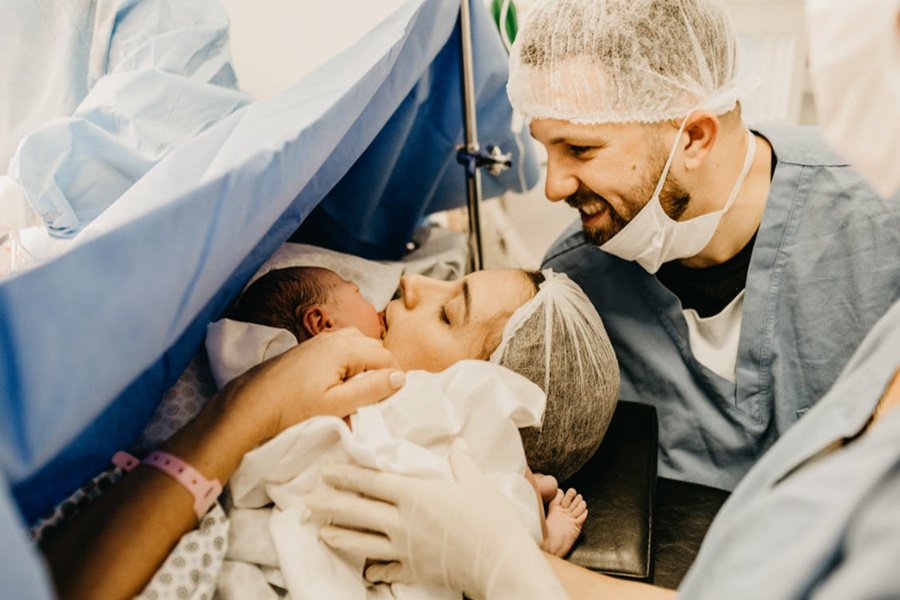Secondary post partum haemorrhage is defined as the bleeding from the genital tract more than 24 hours after delivery of placenta; it may occur up to six weeks later. It is more likely to occur between 10 and 14 days after delivery.
Signs and Symptoms of Secondary Post Partum Haemorrhage
- Cold clammy extremities; due to channeling of most blood towards the central circulation.
- An enlarged uterus; due to blood clots and other retained products of conception in the uterus.
- Oliguria or anuria; this is due to reduced blood supply to the renal system.
- Maternal collapse; this could be due to reduction in blood supply to the vital organs leading to shock and collapse.
- Pallor; this is due to vasoconstriction to compensate for the excess blood loss and send most of the blood to the central circulation.
- Altered level of consciousness, the mother may become restlessness or drowsy.
- tarchychadia
- Decreased blood pressure.
- Increased respiration
- confusion
- Visible excess bleeding.
Factors that May be Responsible for Secondary Post Partum Haemorrhage
- Infection
- Retained products of conception
- Sub-involution.
- Uterine atony.
- Pre-eclampsia.
- General anaesthesia.
- Previous history of post partum haemorrhage.
- Ante-partum haemorrhage.
- Blood clotting defect.
- Unknown ateiology.
Read Also: How To Mange A Woman In Third Stage Of Labour
The Three Basic Principles of care of Post Partum Haemorrhage.
Call For Medical Aid:
- It is necessary that you call for assistance, in case the condition turn to become worse.
- Encourage other midwives, students or relatives too actively participate in the care of the woman.
- Continue to care and handle the condition until the doctor arrives.
- Find out the cause and direct your action.
- Check if there is any perineal or other genital tract laceration.
- Palpate the abdomen to detect the presence of uterine rupture.
- Check for uterine atony.
- Check for the presence of blood clotting defect
Resuscitate The Mother:
This will help her to regain her lost fluid
- Administer prescribed intravenous fluid.
- Set up blood transfusion if ordered.
- Lift her legs to enable blood drains from them into the circulation.
- Apply non-pneumatic anti shock garment which helps to apply pressure , reduce blood loss and return most of the blood to the central part of the body thereby preventing shock.
Stop The Bleeding:
This involves treating the cause
- Rub up contractions.
- Give uterotonic drug to sustain the contraction.
- Put baby to the breast.
- Empty the bladder by passing urinary catheter if she can’t empty it by herself.
- Empty the uterus through delivering the placenta if not yet delivered and remove any blood clots and remains of conception.
- Perform bi-manual compression of the uterus if bleeding continues after delivery of placenta.
- Suture any genital tract laceration.
- Give prescribed vitamin K in case of blood clotting defects.
Possible Nursing Diagnosis of a Patient with Post partum haemorrhage
- Deficient fluid volume related to haemorrhage evidenced by low blood pressure of 90/50mHg
- Anxiety related to the unknown outcome of the bleeding evidenced by restlessness.
- Imbalance nutrition less than body requirements related to loss of fluid evidenced by sunken eyes and loose clothing.
- Risk for infection, related to bleeding control measures.
- Fatigue related to blood loss evidenced by her verbalization of weakness.
How To Prevent Secondary Post Partum Haemorrhage
- Maintain aseptic techniques during and after labour to prevent infection.
- Maintenance of personal and environmental hygiene to prevent infection.
- Proper management of pre-eclampsia/eclampsia before or after labour.
- Performing antenatal and post natal exercise.
- Proper use of uterotonic drugs after delivery especially when labour was augmented.
- High risk women should deliver in a hospital with well experienced hands, and should be monitored regularly for many days before discharge.
- Complete removal of the products of conception.
- Administration of vitamin K to mothers with blood clotting defect.
We hope this information was helpful. Feel free to ask your questions in the comment section below.



